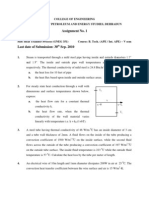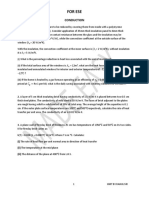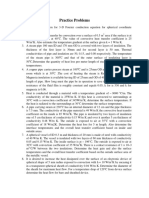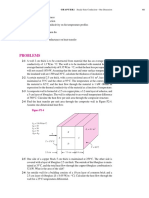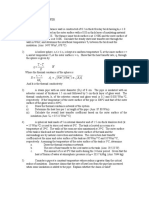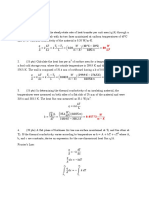Tutorial Number4conduction
Uploaded by
Niraj PSTutorial Number4conduction
Uploaded by
Niraj PSTUTORIAL NUMBER 4
1. Derive the general equation governing thermal conduction in spherical coordinate system. 2. Starting with
where T is the temperature (K), x is the distance (m), q is the heat generation (W/m3),k is the conductivity (W/mK), L is the thickness of the wall (m). Obtain an expression for the temperature distribution of a homogeneous wall with surface temperature T1 (at x=0) and T2 (at x=L). 3. Derive an expression for the steady state temperature within a solid wall of conductivity k (W/m K) and uniform internal heat generation qg W/m3. Assume that the x coordinate is 0 at the one end of the wall which has a constant temperature T0 (oC) and the other end is at x=x1 (m) and has a constant temperature T1 (oC). 4. For problem 3, if To = 20 oC, T1 = 100 oC, x1=2 m, k = 10 W/m K and qg= 30W/m3, calculate the temperature at the centre of the wall. 5. An insulated pipe of thickness 2cm and an inner radius of 0.5m and a thermal conductivity of 40 W/m K. It is insulated from outside by a material of thickness 3cm and thermal conductivity of 2 W/m K. A fluid of temperature 500oC is flowing through the pipe which has a convection coefficient of 20 W/m2 K. The fluid outside the insulation has a temperature of 20oC and a convection coefficient of 3 W/m2.K. Calculate the overall thermal resistance and heat flow per unit length of the pipe.
6. A thin wall copper tube of radius 5 mm is used to transport refrigerant. Heat is lost to the ambient, which is at a lower temperature. Verify that there is an optimum thickness associated with the application of insulation that can be used on the tube given in terms of the critical insulation radius (rcrit). State all the assumptions used in the above. The conductivity of the cellular glass insulation proposed in this case is 0.055 W/mK and the outer surface convective coefficient is 5 W/m2 K. Calculate the critical insulation radius and sketch the expected variation of the thermal resistance with radius of insulation used.
You might also like
- Problem Set - I: Shri Ramswaroop Memorial UniversityNo ratings yetProblem Set - I: Shri Ramswaroop Memorial University4 pages
- Problem Sheet-02 - ME502 - Steady Heat Conduction100% (1)Problem Sheet-02 - ME502 - Steady Heat Conduction3 pages
- Tutorial-Module_2_1738239637964697291679b6e95834b8No ratings yetTutorial-Module_2_1738239637964697291679b6e95834b810 pages
- CL-204 (Heat Transfer Operations) : Assignment: 2No ratings yetCL-204 (Heat Transfer Operations) : Assignment: 211 pages
- Electrical Analogy of Heat Transfer: Simple Ideas To Eliminate Discontinuities in Solution DomainNo ratings yetElectrical Analogy of Heat Transfer: Simple Ideas To Eliminate Discontinuities in Solution Domain29 pages
- Assignment 1 - Insulin Delivery System: 1 BackgroundNo ratings yetAssignment 1 - Insulin Delivery System: 1 Background3 pages
- Autocad: Mech 1009 - Assignment For WK 8No ratings yetAutocad: Mech 1009 - Assignment For WK 81 page













